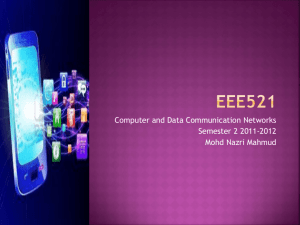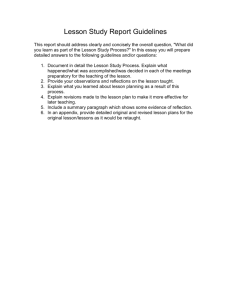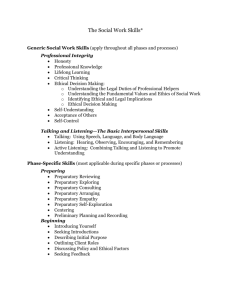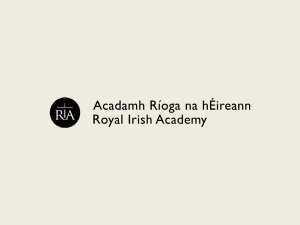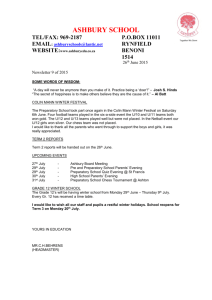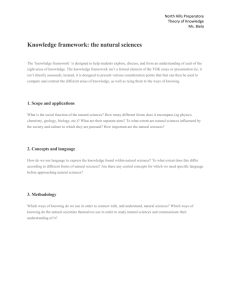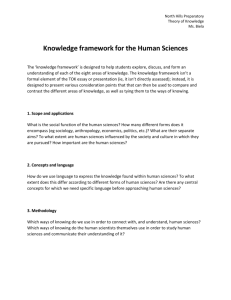EEE521
advertisement
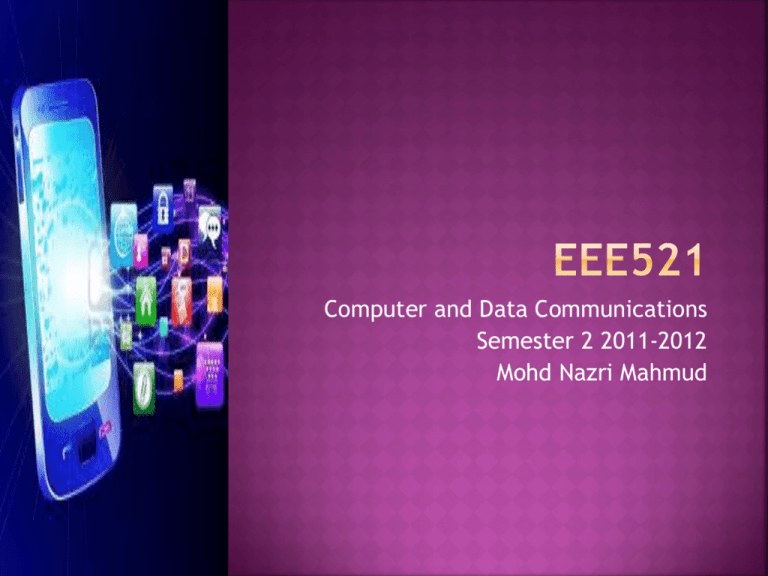
Computer and Data Communications Semester 2 2011-2012 Mohd Nazri Mahmud Course overview Teaching Lecturers Assessment Resources Software Tools Syllabus Lesson Plan Background Survey Grouping Pre-requisite for this course: Knowledge of undergraduate level course on Computer Networks Those who have not acquired the fundamentals are advised to read the recommended books Objectives of the course: To learn the theoretical and practical issues relating to the-state-of-the-art on computer and data communication network Learning Methods: In-class Problem Based Discussion (PBD) sessions In-lab Group Experiential Learning (GEL) sessions Lecturers: En. Mohd Nazri Mahmud, nazriee@eng.usm.my Room : 2.14 Dr Kamal Zamli, eekamal@eng.usm Room : 3.22 Theoretical and Problem-based discussion (PBD) Students are advised on topics to be covered and preparatory readings and questions are assigned prior to lecture session Lecturer and students discuss topics interactively based on the preparatory questions Students take their own notes during discussion Group Experiential Learning (GEL) Students carry out modeling, simulation and performance analysis of protocols in groups of 3-5 students Groups share their findings in class Group project 60% Final Exam 40 % Coursework; 20% from each lecturer 20% Coursework from En. Nazri’s part consists of 5% Test - Individual 5% Assignment – Individual and In group 10% Project - Group Group work Group Experiential Learning(GEL) and Project (10%) Group Paper presentation (2.5%) Individual work Individual Test – 5 % Individual Written Assignment and Paper review assignment - 2.5% Reference books Main textbook: Data Communications and Networking 4th Edition by Behrouz A. Forouzan, McGraw Hill Journal Papers Survey papers for group presentation Research papers for individual paper review assignment A list of papers will be provided for selection Supporting resources Can be downloaded from my academic webpage: http://ee.eng.usm.my/eeacad/nazriee/teaching.html Supporting Slides Reading handouts Preparatory questions Lab sheets OPNET Extensively use throughout the first 7 weeks for modelling, simulation and performance analysis of protocols Must be individually downloaded Free from OPNET’s website IT Guru Academic Edition http://www.opnet.com/university_program/itguru_ac ademic_edition/ Try out the tutorial for quick familirisation before the first lab session Data Link Layer of the TCP/IP networks Contention-based Medium Access Control for wired and wireless networks Performance Analysis of the Wired and Wireless Ethernet Medium Access Control for Emerging Wireless Networks (based on group paper presentation and individual paper review) Network Layer of the TCP/IP networks Internetworking: Addressing, Forwarding Routing Protocols: RIP, OSPF and BGP Multicasting Week 1 Lesson Plan 20/2 • Course Introduction and briefing Session 1a • Survey of students background • Grouping • Distribute list of papers for group and individual selection • Distribute preparatory readings and questions: TCP/IP, MACs and LANs. 21/2 • Review the TCP/IP layered architecture via an open book Session 1b group quiz • Data Link Layer discussions focusing on Medium Access Control based on preparatory questions, LANs and the Ethernet based on preparatory questions Week 2 Lesson Plan 27/2 Session 2a Group Experiential Learning 1: • OPNET basic tutorial • Modelling, Simulation and Performance Analysis of IEEE 802.3 Ethernet and MAC. 28/2 Session 2b Group Experiential Learning 1-– continue work from Lab session 1 Week 3 5/3 Session 3a 6/3 Session 3b Lesson Plan •Reflection for Lab work from Session 2a and b via selected group results presentation •Discussion on CSMA/CA and IEEE 802.11 MAC protocol based on preparatory readings and questions Session 3b: Group Experiental Learning 2: Modelling, simulation and performance analysis of IEEE 802.11 MAC protocol Week 4 12/3 Session 4a 13/3 Session 4b Lesson Plan •Reflection for Lab work from Session 3b via results presentation by selected groups •Group Presentation on Survey paper for MACs for other wireless networks Continue Group Presentation on Survey paper for MACs for other wireless networks. Week 5 19/3 Session 5a 20/3 Session 5b Lesson Plan •Discussion on the Network Layer, Internetworking based on Group Quiz •Addressing, Forwarding, Unicast Routing based on preparatory readings and questions Session 4b: Lab work and assignment on Unicast Routing Protocols Week 6,7 Plan Session 5a: Reflection for Lab work from Session 5b 26/3 Session 6a Multicasting 27/3 Session 6b Labwork on Network Designs and Group Project 7 2/4 Session 7a 3/4 Session 7b Overall review Individual Test on theories and practice 8 Continue with the TCP and Application Layer with Dr. Kamal No of students who have taken related UG courses Examples of UG courses Detail survey via questionaires Preparatory readings for Session 1b – First part Read textbook 1, Chapter 2: Students with no background are advised to read the whole of Ch 2 Prepare for group open book quiz Quiz will focus on Section 2.3 Layers and 2.4 The TCP/IP protocol suite and prepare for group quiz Preparatory reading for Session 1b – Second part Read textbook Chapter 12: 12.1 Random Access, Chapter 13: Ethernet focus on 13.1 MAC Frames Read Preparatory notes for Interconnecting LANs Attempt preparatory questions Prepare for participation in class
